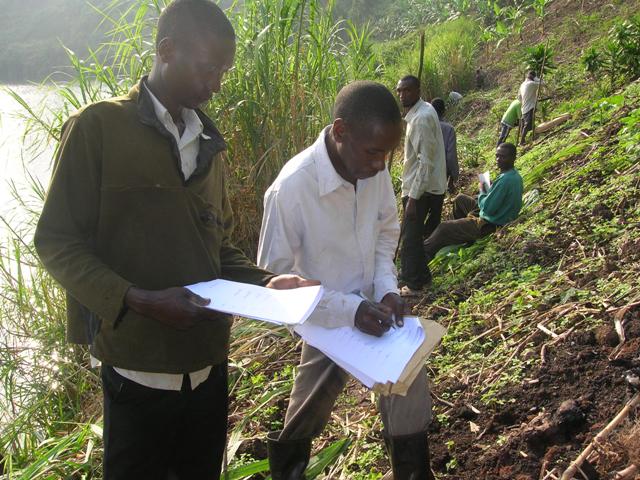It is against that background and purpose that GWPEA team undertook a field visit towards Mushumba Community Initiatives for Development (MCID), a community based organization located in Ryeru Sub County, Rubirizi district- in Uganda. MCID was established in 2010 with a mission to improve the well-being of its members through community driven initiatives. The Mushumba community members have had water challenges for over a decade. The challenges were due to siltation from the degraded neighboring steep slopes causing turbidity and safety of the water. In 2012, MCID received financial support from the embassy of Japan in Uganda which constructed a pumped water system to provide clean and safe water for the communities. In 2013, the community organization received additional support USD 6000 from UNDP Uganda office to undertake interventions aimed at reducing siltation of Lake Kako
The main objectives of the interventions were to:
-
Restore and protect Lake Kako against siltation.
- Reduce run-off resulting from degradation of the steep slopes surrounding L. Kako.
- Promote sustainable alternative sources of energy for domestic cooking.
The stakeholders agreed to undertake the following actions to address some of the challenges.
- Hold meetings to discuss potential interventions and carrying out sensitization of the community members around the L.Kako
- Establish Mushumba community Lake Kako Management committee to oversee interventions on and around the lake
- Explored ways of supporting farmers with inputs such as planting trees seedlings & ground cover plants on the steep slopes surrounding L.Kako
- Raising awareness on sustainable renewable energy technologies that can easily be adopted and replicated
- Identification and training of local artisans in solar cooker installation and maintenance
- Identification of demonstration sites and installation of solar cookers as pilot initiatives
The assessment of GWPEA team on ground has evidenced that Mushumba Community Initiatives for Development (MCID) can be a good case study for Drought Resilience due to the following reasons:
- As far as the IWRM is concerned, the coordination of land use interventions will promote sustainable water supply in the Lake Kako area. For example the interventions by the community such as tree planting and Vertiver grass growing along the slopes surrounding Lake Kako is protecting depletion of the lake water source. The communities are able to invest the time they used to spend fetching water to better economic use and improve their social welfare. At the same time, the interventions will help restore the degraded ecosystem.
It is worth noting that the establishment of Lake Kako Management Committee to oversee the activities on and around the lake during and after the project period has created a sense of project ownership. This has ensured continuation of activities. A larger part of the steep slopes within the surrounding areas need immediate attention with regard to activities that reduce land degradation. The needed actions include soil and land management measures like tree planting, terraces, mulching, digging trenches, and establish grass bands. These are important in reducing possibilities of occurrence of mudslides and landslides and severe run-off. Meanwhile, alternative livelihood sources and energy options like solar cooking technology that has proved to be an efficient sustainable energy source for domestic cooking need to be replicated.
Photo: A farmer signs off an MoU to express his willingness to change his land usage.
